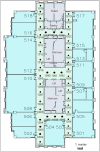Few-Shot Learning in Wi-Fi-Based Indoor Positioning
- PMID: 39329573
- PMCID: PMC11430087
- DOI: 10.3390/biomimetics9090551
Few-Shot Learning in Wi-Fi-Based Indoor Positioning
Abstract
This paper explores the use of few-shot learning in Wi-Fi-based indoor positioning, utilizing convolutional neural networks (CNNs) combined with meta-learning techniques to enhance the accuracy and efficiency of positioning systems. The focus is on addressing the challenge of limited labeled data, a prevalent issue in extensive indoor environments. The study explores various scenarios, comparing the performance of the base CNN and meta-learning models. The meta-learning approach involves few-shot learning tasks, such as three-way N-shot, five-way N-shot, etc., to enhance the model's ability to generalize from limited data. The experiments were conducted across various scenarios, evaluating the performance of the models with different numbers of samples per class (K) after filtering by cosine similarity (FCS) during both the stages of data preprocessing and meta-learning. The scenarios included both base classes and novel classes, with and without meta-learning. The results indicated that the base CNN model achieved varying accuracy levels depending on the scenario and the number of samples per class retained after FCS. Meta-learning performed acceptably in scenarios with fewer samples, which are the distinct datasets pertaining to novel classes. With 20 samples per class, the base CNN achieved an accuracy of 0.80 during the pre-training stage, while meta-learning (three-way one-shot) achieved an accuracy of 0.78 on a new small dataset with novel classes.
Keywords: cosine similarity; few-sample learning; few-shot learning; indoor positioning; limited labeled data; meta-learning.
Conflict of interest statement
The authors declare no conflict of interest.
Figures
References
-
- Spachos P., Plataniotis K.N. BLE Beacons for Indoor Positioning at an Interactive IoT-Based Smart Museum. IEEE Syst. J. 2020;14:3483–3493. doi: 10.1109/JSYST.2020.2969088. - DOI
-
- Magnago V., Palopoli L., Buffi A., Tellini B., Motroni A., Nepa P., Macii D., Fontanelli D. Ranging-Free UHF-RFID RobotPositioning Through Phase Measurements of Passive Tags. IEEE Trans. Instrum. Meas. 2020;69:2408–2418. doi: 10.1109/TIM.2019.2960900. - DOI
-
- Carotenuto R., Merenda M., Iero D., Della Corte F.G. An Indoor Ultrasonic System for Autonomous 3-D Positioning. IEEE Trans. Instrum. Meas. 2019;68:2507–2518. doi: 10.1109/TIM.2018.2866358. - DOI
-
- Liu F., Liu J., Yin Y., Wang W., Hu D., Chen P., Niu Q. Survey on WiFi-based indoor positioning techniques. IET Commun. 2020;14:1372–1383. doi: 10.1049/iet-com.2019.1059. - DOI
LinkOut - more resources
Full Text Sources





